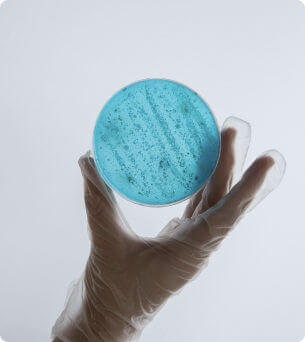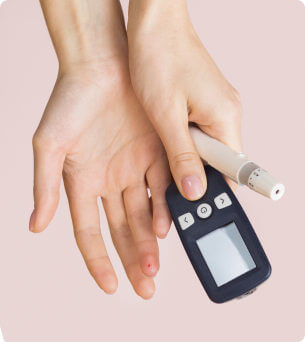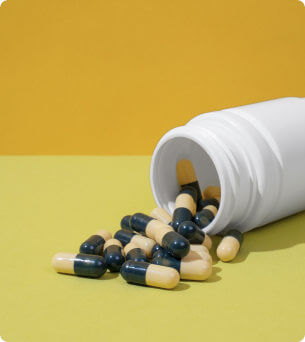Altered discharge, itching, and red discoloration of the skin. As a woman, the likelihood is high that you will experience it at some point in your life; a vaginal yeast infection is, in fact, a common issue. 75% of all women will experience a vaginal yeast infection in their lifetime. It is caused by an overgrowth of fungi in the vagina, usually the yeast Candida albicans. In this blog, we will discuss what a vaginal yeast infection exactly is, the symptoms, possible causes, the duration of the infection, and treatment options. Additionally, we will provide you with some useful tips on how to prevent a vaginal yeast infection in the future. Keep reading to learn more.

What is a vaginal yeast infection?
A vaginal yeast infection is a common condition that can affect women of all ages. In a vaginal yeast infection, the normal balance of microorganisms in the vagina is disrupted. In the usual situation, there are various fungi and bacteria present in the vaginal area, forming the normal microbiome of the vagina. Candida albicans is a type of yeast that naturally occurs in the vagina. Yeast is a single-celled fungus, which is why a Candida infection falls under fungal infections. When the vaginal balance is disturbed, certain microorganisms can overgrow. Candida albicans is one of the most common fungi that can cause such overgrowth. In the normal situation, there are always small amounts of Candida present in the vagina. However, due to certain factors such as the use of antibiotics or hormonal changes, the Candida yeast can overgrow and potentially cause symptoms. The symptoms resulting from this overgrowth are detailed below.


Symptoms of a vaginal yeast infection
When there is a disrupted balance and overgrowth of Candida, it can cause various symptoms. However, it is important to note that not everyone with an overgrowth of Candida experiences symptoms. Nevertheless, the following symptoms may occur:
- Itching in and around the vagina: A common sign of a Candida infection is itching specifically localized in and around the vagina. This itchiness can vary in intensity and can be a source of discomfort and irritation.
- Burning sensation during urination or intercourse: In a Candida infection, a burning sensation may occur during urination or intercourse. This can be accompanied by a feeling of irritation or sensitivity in the genital area.
- White, chunky discharge: Another characteristic symptom of a Candida infection is the presence of white, chunky discharge. This discharge may resemble cottage cheese and may have an unpleasant odor.
- Redness and swelling of the vulva: In a Candida infection, redness and swelling of the vulva, the outer part of the female genital organs, may occur. This can be accompanied by a feeling of sensitivity and pain.




It is important to note that these symptoms are not specific to Candida infections and can also occur with other conditions. Therefore, at Easly, we have developed the female intimate health test, which not only tests for Candida but also for other microorganisms that can cause the mentioned symptoms. You can easily take the test at home.
Now you know what the symptoms are of an overgrowth of Candida yeast. But how can you develop an overgrowth?
Causes of a vaginal yeast infection
As mentioned earlier, symptoms of a vaginal yeast infection are caused by an overgrowth of Candida yeast. There are various factors that can contribute to the development of a vaginal yeast infection. Below, we describe some of these factors:
- Changes in hormonal balance: Fluctuations in hormones, such as during the menstrual cycle or pregnancy, can disrupt the vaginal flora. This disruption can create an environment where Candida yeast can multiply.
- Use of certain medications: The use of certain medications, especially antibiotics, can disturb the normal vaginal flora. Antibiotics can not only kill harmful bacteria but also the good bacteria that keep Candida yeast in check. This can lead to an overgrowth of Candida and the onset of a yeast infection.
- Weakened immune system: A weakened immune system can increase the risk of a vaginal yeast infection. Illness, stress, poor nutritional status, or the use of immunosuppressive medications can all contribute to a reduced immune response against Candida yeast. Diabetes mellitus (diabetes): In people with diabetes mellitus, the sugar (glucose) level in the body is elevated. Candida yeast thrives in an environment with increased sugar levels, making people with diabetes at an increased risk of vaginal yeast infections.


It is important to note that these factors can increase the risk of developing a vaginal yeast infection, but not everyone with these factors will automatically get an infection. Additionally, a significant portion of Candida infections may not have a specific underlying cause.

Treatment and duration of a vaginal yeast infection
The duration of a vaginal yeast infection can vary depending on various factors. Generally, it can improve within a week with the appropriate treatment.
The treatment of a vaginal yeast infection typically involves antifungal medication, such as vaginal creams or tablets, applied locally. These medications help to kill the Candida yeast and reduce symptoms.



After starting the treatment, an improvement in symptoms can be observed within a few days. However, it is important to complete the full prescribed course of treatment, even if the symptoms disappear, to ensure that the infection is fully addressed.
Related tests


What to do in case of recurring vaginal yeast infections?
In some cases, the symptoms may persist or recur, indicating a chronic or recurrent yeast infection. A chronic yeast infection refers to an infection that lasts for an extended period and is challenging to treat. Recurrent yeast infections refer to the repeated occurrence of infections, usually with intervals of several months.
Various factors can contribute to the development of chronic or recurrent yeast infections. These may include underlying health issues such as diabetes or a weakened immune system, making it difficult for the body to effectively combat the Candida yeast. Additionally, other factors such as not adhering to the prescribed treatment course, hormonal changes, or disruption of the vaginal flora can contribute to the recurrence of the infection.


If the symptoms persist or recur, it is important to consult a doctor for further examination and treatment. The doctor may conduct additional tests to determine the cause of the persistent infection.
How to prevent vaginal yeast infections
While it may not always be possible to completely prevent a vaginal yeast infection, there are several important measures you can take to reduce the risk of infections:
- eep the vagina clean and dry: It’s essential to keep the vagina clean, but avoid using soap inside the vagina. Soaps can disrupt the natural pH balance and promote the growth of fungi. Using water alone is sufficient.
- Wear cotton underwear: Synthetic materials can trap moisture and create a warm environment where fungi thrive. Wearing breathable cotton underwear can help wick away moisture and improve ventilation, keeping the vagina dry and less susceptible to infections. It’s also important to avoid tight, restrictive clothing, as it can cause friction and moisture accumulation.
- Avoid prolonged wearing of wet swimwear: Walking around in wet swimwear after swimming or sweating can trap moisture and promote fungal growth. Ensure you change into dry clothing after swimming or sweating to prevent a damp environment conducive to fungal flourishing.
- Limit the use of antibiotics: Antibiotics can disrupt the natural balance of bacteria in the vagina, allowing fungi to take over and cause an infection. Use antibiotics only when strictly necessary and always follow the prescribed dosage.
- Boost your immunity: A weakened immune system makes it easier for Candida yeast to overgrow in the vagina. Maintain a balanced and healthy diet, get enough sleep, and try to limit stress.




By following these measures, you can reduce the likelihood of developing a vaginal yeast infection. However, it’s important to remember that even with the best preventive measures, a vaginal yeast infection can still occur. If you experience symptoms such as itching, a burning sensation, abnormal discharge, or redness, it is advisable to contact your doctor or take the yeast infection or bacterial infection test from Easly.
Conclusion
In this blog, we have extensively discussed the symptoms, causes, treatment, and prevention of vaginal yeast infections. Vaginal yeast infections are very common, and most women will experience them at some point in their lives. If you are experiencing symptoms such as itching, altered discharge, or a burning sensation, it could be indicative of a vaginal yeast infection. Through Easly, you can easily and reliably determine whether your symptoms are caused by a yeast infection with the female intimate health test. Fortunately, a vaginal yeast infection is easily treatable. Always maintain a healthy lifestyle to adequately support your body in preventing a vaginal yeast infection.








